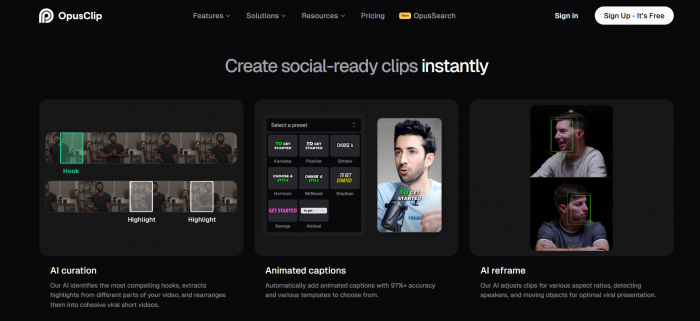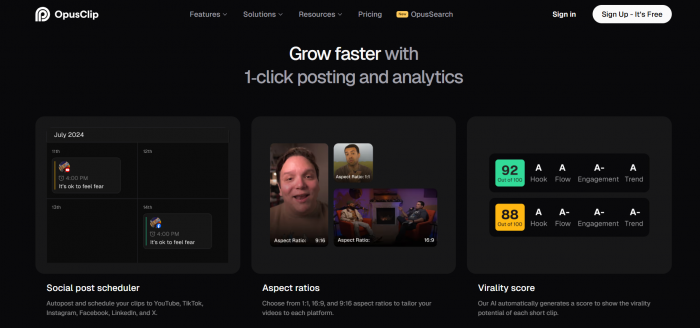On This Page
- What Is Opus Clip and Who Uses It?
- One Click to Viral”: The Core Promise Explained
- Key Features the Platform Highlights
- How Opus Clip Works Under the Hood?
- Use Cases: What Creators Use It For
- Pricing Overview: Free vs Paid Tiers
- Real User Reviews: What People Actually Think
- Ethical and Practical Considerations
- Final Verdict: Is Opus Clip Worth Trying?
AI tools have started replacing manual editing workflows, and Opus Clip is at the forefront of this movement—especially for video creators. It promises to transform long-form videos into short, viral-ready clips with minimal input.
But does the tool live up to its marketing claims, or is it another AI product that overpromises?
Let’s examine what it does and what users say about it.
What Is Opus Clip and Who Uses It?

Opus Clip describes itself as an AI-powered video clipping tool designed to repurpose long-form content into short-form clips tailored for platforms like TikTok, YouTube Shorts, and Instagram Reels.
Its target users include:
- YouTubers and podcasters
- Educators and online coaches
- Marketers and content teams
- Social media managers
The goal is clear: help creators maximize content output without hiring editors or learning complex software.
One Click to Viral”: The Core Promise Explained

Opus Clip markets its product with the phrase “One Click to Viral.” The idea is that creators can upload a long video, and the platform’s AI will automatically:
- Identify high-engagement segments
- Reframe for vertical viewing
- Add subtitles, emojis, and transitions
- Score each clip with a Virality Score™
These claims are outlined on their homepage, though what qualifies a clip as “viral” isn’t publicly benchmarked or defined by third-party standards.
Now let’s take a closer look at the feature set.
Key Features the Platform Highlights
According to Opus Clip’s feature overview, here are the features it currently offers:
- AI Curation – Finds "golden moments" automatically
- Active Speaker Detection – Keeps speakers centered
- AI Virality Score™ – Rates clips based on hook and structure
- AI Co-Pilot – Allows manual refinement with AI suggestions
- Auto Reframing – Adjusts for 9:16 vertical formats
- B-Roll Insertion (Beta) – Auto adds supplemental visuals
- Auto Subtitles – With customization and accuracy tuning
- Emoji & Highlight Overlays – Adds animated emphasis
- Brand Templates – Applies consistent style across clips
- Multilingual Subtitles – Expands reach for non-English audiences
The features are impressive for quick social content, but how does the AI actually operate?
How Opus Clip Works Under the Hood?
The platform claims to use natural language processing, voice detection, and emotion analysis to detect engaging moments in videos. It then cuts those into short clips, formats them, and scores them for virality.
There’s limited technical documentation available, so the true mechanics remain largely proprietary. No peer-reviewed evaluations or open-source disclosures are available as of May 2025.
However, users and reviewers have weighed in with more concrete feedback.
Use Cases: What Creators Use It For
Based on community feedback from Reddit and Product Hunt, the most common use cases include:
- Breaking down hour-long podcasts into 10–15 shorts
- Creating bite-sized educational content
- Generating Instagram Reels from YouTube tutorials
- Quickly producing sales or coaching highlights for social meida
Now let’s talk about pricing.
Pricing Overview: Free vs Paid Tiers
According to the Opus Clip pricing page, the platform offers:
| Plan | Price | Key Features |
| Free | $0 | 60 mins/month, watermark included |
| Creator | $19/month | 300 mins, watermark-free, brand templates |
| Pro | $59/month | 1,000 mins, team access, priority rendering |
Compared to other tools like Pictory or Descript, Opus Clip offers more aggressive pricing but fewer advanced editing capabilities.
How does this pricing reflect in user satisfaction?
Real User Reviews: What People Actually Think
G2 (4.6/5 rating – source)
“I use this for my podcast. It saves me so much time. The subtitles are spot on, and the virality score is a fun touch. That said, it sometimes clips in the middle of sentences.”
— James H., Podcast Host
“It’s great for basic edits, but I wish there were more font and emoji customization options. Emojis can feel forced.”
— Emily R., Social Strategist
Product Hunt (Ranked #1 Product of the Day – source)
“The tool made my content look 10x better. I turned a boring Zoom call into five engaging clips.”
— @yusuf_dev
“Good for short-form, but still needs polish. Auto-B-roll is hit-or-miss.”
— @tiktoktrainer
Reddit (r/YouTubers & r/ContentCreation – sources
“Great tool if you’re cranking out a lot of content. I use it to generate daily TikToks from my Twitch streams.”
— u/FilmEditorDude
“I tried it on a coaching session, and it cut too close to key talking points. Had to re-edit a lot. Good starting point, but not hands-off.”
— u/BrandCoach101
Trustpilot (As of now: no formal listing, unofficial user mentions only)
There’s currently no verified Trustpilot page for Opus Clip, which suggests the platform is still in early adoption stages and growing its trust profile.
Ethical and Practical Considerations
Opus Clip allows users to manipulate footage through clipping, reframing, and enhancement—which raises ethical concerns:
- Contextual Misrepresentation: Clips may mislead if not reviewed
- Attribution & Consent: Using third-party video must follow copyright laws
- AI Disclosure: Currently, there’s no watermark or disclosure that a video is AI-generated
- Platforms like Synthesia recommend AI-origin disclaimers, but Opus Clip does not appear to include this by default.
Users are encouraged to review and approve all clips before publishing.
Final Verdict: Is Opus Clip Worth Trying?
Opus Clip appears to be a powerful tool for creators looking to scale their short-form content strategy. It saves time, offers relevant features, and provides value—especially for solopreneurs and marketers.
Recommended for:
- Creators who already produce long-form video
- Anyone needing quick TikTok/Shorts output
- Small teams without dedicated video editors
Not ideal for:
- Full-scale video production or storytelling
- Creators needing tight visual branding control
- Sensitive or nuanced content (e.g., political interviews)
With a generous free plan and strong user feedback, it's worth testing—but creative oversight remains essential.
Post Comment
Be the first to post comment!





